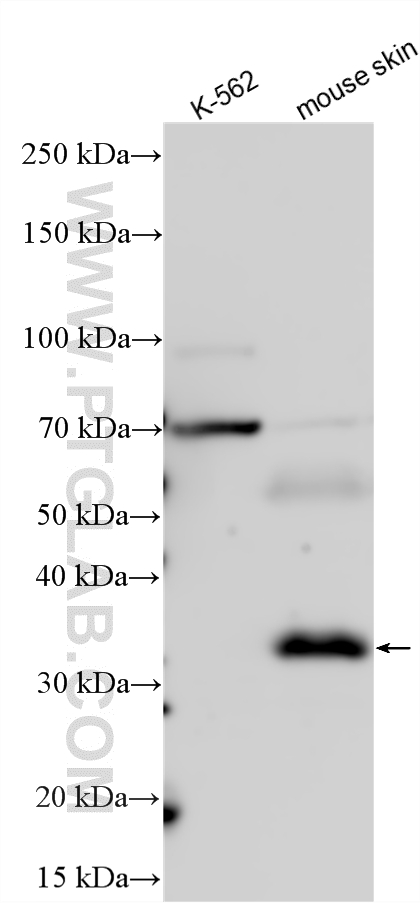验证数据展示
经过测试的应用
| Positive WB detected in | mouse skin tissue |
推荐稀释比
| 应用 | 推荐稀释比 |
|---|---|
| Western Blot (WB) | WB : 1:1000-1:4000 |
| It is recommended that this reagent should be titrated in each testing system to obtain optimal results. | |
| Sample-dependent, Check data in validation data gallery. | |
产品信息
15332-1-AP targets TPSB2 in WB, ELISA applications and shows reactivity with human, mouse samples.
| 经测试应用 | WB, ELISA Application Description |
| 经测试反应性 | human, mouse |
| 免疫原 |
CatNo: Ag7335 Product name: Recombinant human TPSB2 protein Source: e coli.-derived, PGEX-4T Tag: GST Domain: 33-282 aa of BC065923 Sequence: LQRVGIVGGQEAPRSKWPWQVSLRVHGPYWMHFCGGSLIHPQWVLTAAHCVGPDVKDLAALRVQLREQHLYYQDQLLPVSRIIVHPQFYTAQIGADIALLELEEPVKVSSHVHTVTLPPASETFPPGMPCWVTGWGDVDNDERLPPPFPLKQVKVPIMENHICDAKYHLGAYTGDDVRIVRDDMLCAGNTRRDSCQGDSGGPLVCKVNGTWLQAGVVSWGEGCAQPNRPGIYTRVTYYLDWIHHYVPKKP 种属同源性预测 |
| 宿主/亚型 | Rabbit / IgG |
| 抗体类别 | Polyclonal |
| 产品类型 | Antibody |
| 全称 | tryptase beta 2 |
| 别名 | EC:3.4.21.59, TPS2, Tryptase 2, tryptase beta 2, Tryptase beta-2 |
| 计算分子量 | 31 kDa |
| 观测分子量 | 31 kDa |
| GenBank蛋白编号 | BC065923 |
| 基因名称 | TPSB2 |
| Gene ID (NCBI) | 64499 |
| 偶联类型 | Unconjugated |
| 形式 | Liquid |
| 纯化方式 | Antigen affinity purification |
| UNIPROT ID | P20231 |
| 储存缓冲液 | PBS with 0.02% sodium azide and 50% glycerol, pH 7.3. |
| 储存条件 | Store at -20°C. Stable for one year after shipment. Aliquoting is unnecessary for -20oC storage. |
背景介绍
Tryptase beta-2 (TPSB2), also known as TPS2, is a member of the peptidase S1 family and the mast cell-specific tryptase subfamily. It is a serine protease primarily expressed in mast cells and basophils. TPSB2 is synthesized as a proenzyme, stored in secretory granules, and released upon cell activation. It plays a crucial role in allergic reactions and inflammation by cleaving extracellular matrix proteins, activating protease-activated receptors (PARs), and processing cytokines like IL-33. Elevated levels of TPSB2 are associated with conditions such as asthma, allergic rhinitis, and anaphylaxis, making it a biomarker and therapeutic target in these areas.


